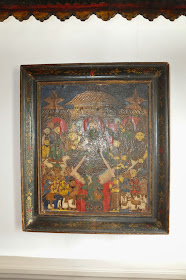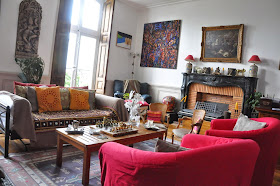Many youthful summers, many evenings loitering the local colony parks & lanes, many Autumnal days & nights during Pujo - year on year- were spent together with her. Ritu, didi (my big-sis), me and a gang of some others (who I am missing terribly as I write), had totally inseparable growing-up-together years, replete with escapades, incidents, some accidents, beguiling and widely discussed crushes (at times on the same boy), sharing of beds, food, sarees & clothing, shoes & secrets and just about everything else that early and teen years are romanced for! The perfect pre-20s of our lives which would not be half as memorable or wild without each other.
Cut to 2014, and I write this post today as a commemorative of our French summer soiree, and the last phase of that vacation spent in the absolutely idyllic city of Nantes, located on the Loire river, in the west of France. (In 2004, Time named Nantes as "the most liveable city in Europe").
Ritu (Ritu Bernaerts now) lives here in Nantes, with two lovely daughters Fiona & Ilona, stunningly gentle & genial Nicolas (her husband), and graceful Twix (the first cat I ever tried to love)!
And she lives! Ritu and Nicolas have built their cherished home in this urban isle, in its untouched 18th century-character-quarters, known as the Feydeau quarters. Unlike centuries back, the Ile (Isle) Feydeau is today joined to the main town and to the Ile Gloriette where the river Loire freely flowed back then. (Ile Gloriette of today is a grand parking area giving way to a local market on Saturdays, very much a colourful & vibrant dry/wet market of fresh produce, nick-knacks and all variety of essentials).
The Feydeau quarters are built mainly in limestone, with ornamental faces framing the facades and wrought-iron balconies, inner courtyards and vaulted staircases. The pomp of these houses are classically expressed as they stand white and serene against the centuries-old milieu.
And visualise this! As you enter one such apartment inside these stylish French Quarters, a blast of India surrounds your senses, almost overwhelmingly - a platter full of colours, engravings, wood, textile, art, craft, sheer warmth & radiance and dotted with stories personal, Indian & French !
I'll let the pictures speak for it.
 |
| Ritu's favourite seat in this theatre:) |
 |
Read the story of the Sewing machine, below
 |
Of the many stories contained in this household of treasures this one is my favourite. In Ritu's own words "My Grand mom's USHA sewing machine which I got shipped from India...When one of my French friends saw it she gladly donated her Grand mom's SINGER sewing machine-table lying in her attic for a long time. The machine & the table fitted perfectly!! Indo-French relations you see..."

 |
| This beautiful piece of art on leather is a collectible from India, handed down from Nicolas' Great-Great-Grand mom |
 |
| Love those tomato red covers on those couches |
 |
An inherited piece from Nicolas' Grandmother
 |
 |
| Carved ornamental faces that frame every doorway and hang over each balcony... surreal ! |
 |
| The centuries old fireplace : heartwarmingly beautiful despite it's purely decorative functionality today |
 |
| And meet Mr. Twix, the most French of 'em all |
 |
| India lined on shelves |

The story continues :
We learnt that restructuring the historical city for urban living took nearly 20 years (since 1926), especially to fill-in the parts of the rivers Erdre and Loire that flowed round the ile Gloriette. The areas where the river once flowed is today recognisable in the strips of lawn bordered by granite.
Where the renovation story gets legendary is that the architects forgot that the houses are built on sandy foundations, and years later, as a result the Feydeau quarters don't stand straight ! Standing crooked, unaligned, though later-on reinforced for their stability, built mainly in limestone, the majesty of these houses indicates the importance of the city's former commercial trade status.
 |
| Tilting, unaligned gorgeous Feydeau Quarters |
The balconies indicate how distinct each floor was; the ground floor was for commercial use only and is dominated by arched windows and reception rooms. Above were the refined & decorated private apartments.
 |
| Ritu's patch of green - a balcony of potted greens, veggies and herbs |
 |
| The facade characterised by ornamental faces and wrought-iron balconies |
 |
| Classic ceilings |
 |
| Original tiles at the entrance of the Quarters |
 |
| These cobbled lanes have braved centuries of walking & trampling by people, horses, carriages & cars |
 |
| Look who we found, lived here! 'Twenty Thousand Leagues under the sea' |
Nantes slave trade port
The opulent life-style in 18th century Nantes was guaranteed by 2 main sources: Africa and America. Ships built and fitted in Nantes ran the triangular trade between France’s number one port at the time, the Guinean coast and the West Indies. The principle was cruelly simple: buy Africans and sell them on for sugarcane to be refined in Nantes. This is how colonial products like coffee, cocoa, pepper, indigo and exotic wood came to be unloaded along the quayside of Quai de La Fosse and île Feydeau. It was here, in particular, that the shipbuilders built up their dynasties, leaving behind magnificent examples of the city's architecture
The isle evokes the extravagant way of life the maritime traders led in the 18th century, when the port of Nantes was the biggest in France and one of the most important in Europe.


















































very nice pictures collection and special is second last the street view is amazing..
ReplyDeleteI love that one too, Thanks for stopping by Jenifer!
Delete